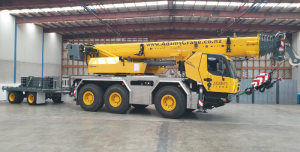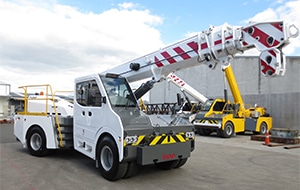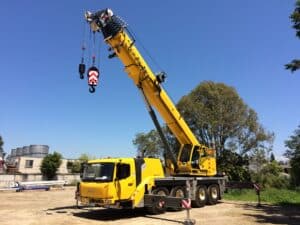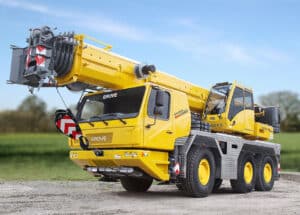The preventable reasons behind why cranes collapse
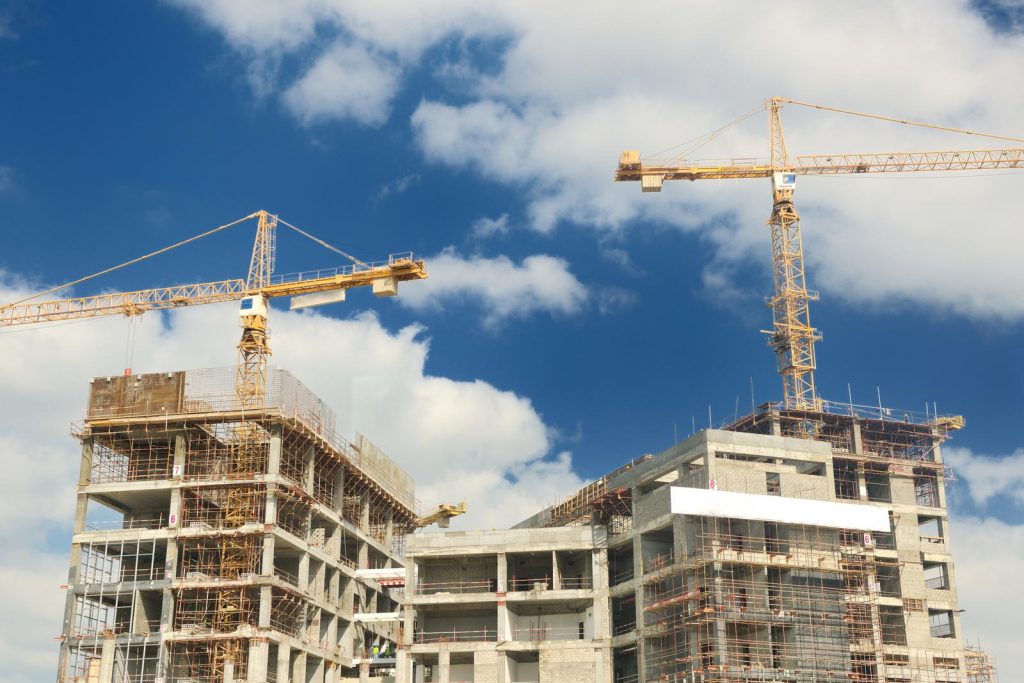
Construction site with crane and building
Cranes can be dangerous because they have the potential to fall over. This is something to keep in mind next time you use a ladder. However, lifting items up and down safely is typically a crane’s only job. So, why do so many of them fall down? Let’s explore some of the biggest crane disasters in recent history to try and understand.
Cranes play a vital role in the majority of construction projects. The construction process can be simplified to material handling, which involves receiving, storing, moving and placing all the various components of a project. Although it is possible to complete construction tasks without the use of a crane by using manual labour and tools, there are many jobs that can only be completed with the help of a crane.
Heavy equipment, like cranes, makes construction projects easier by doing the heavy lifting for workers. Cranes are so important to construction sites that their use is planned in advance, as they are essential for many construction tasks.
Every year, collapsed cranes cause property damage, injuries, and fatalities, but almost all of these accidents are preventable.
Assembly and Disassembly
One of the main reasons why cranes collapse is because they haven’t been assembled or disassembled properly. A lot of the cranes that you see on construction sites are only there for the duration of the project. Once the job is finished, the crane is removed.
That means they either arrived under their own power, called mobile crane, or they were shipped on trucks and assembled on-site, a process that can take days or weeks, depending on the size of the machine
A crane can be extremely vulnerable during assembly or disassembly since all the components aren’t fully bolted together.
A recent collapse in Seattle happened when a team disassembled a tower crane and removed the pins holding sections of the tower together prematurely. Presumably, this was done to speed up disassembly. However, when the winds picked up that day, the crane’s major components became disconnected and it was only held together by gravity and loose sliding connections between the members. The crane soon collapsed, killing four people and injuring many more.
In most cases, the cranes are expertly engineered for worst-case conditions, but the manufacturers are rarely the ones installing them on site. They provide detailed manuals for the crews assembling and disassembling them. Although the manuals for crane operation are very specific, they are not always followed exactly.
One of the worst crane disasters in recent history occurred in New York City in 2008. The workers were in the process of attaching a tower crane to a building when a large and heavy steel collar, which was a key part of the attachment hardware, suddenly fell. When it fell, it hit and broke the attachment points below, causing the whole crane to topple over.
The accident was caused by the crew not following the manual when assembling the crane. The collar was not attached to the crane according to the manufacturer’s guidelines while it was bolted together and attached to the building. Seven people died as a result.
In 2006, another collapse occurred in Battery, England, when the operator was using the wrong manual to assemble the crane. Instead of an eight-tonne counterweight, they used twelve tonnes, putting the crane way out of balance.
Eventually, the bolts holding the slew ring failed and the entire boom broke free, killing the operator and another person who was just fixing his car on the street nearby. Even after a crane is set up, there are still challenges in maintaining it.
Overloading The Crane
One of the main causes of crane failures is overloading, which often occurs during regular operations. Every crane has a weight limit, but it is not as straightforward as something like a bridge, which has one maximum load. This is because most cranes can be configured in different ways, with different counterweights, jib lengths and boom sizes.
Additionally, cranes are designed to move, which further complicates things.
The load limitations for a crane depend on the crane’s ability to balance the load. Every crane has a tipping line, which is the line at which the machine will tip if it is overloaded. Any increase in weight outside the tipping line destabilizes the crane if it is not balanced on the other side. The further away the load is from the tipping line, the greater the moment or torque on the crane.
The amount of force required to tip the crane over can be estimated using a spring scale at different distances from the tipping line. The further the distance from the crane, the less force is required to tip it, as torque is the product of length and force.
Cranes use counterweights and outriggers to keep loads in balance. Counterweights oppose the torque by balancing it on the opposite side of the crane. Outriggers extend the tipping line, bringing it closer to the load and thus reducing the length of the lever.
The crane can barely hold up a spring scale without the outriggers extended but can hold several hundred grammes with them. All those factors add up to a lot more than any operator can be expected to keep track of, which is why cranes have load charts.
Reading these charts is pretty simple. As long as you’re looking at the one that matches the configuration of your crane, look at the furthest radius your hook will be from the centre line of the crane during the lift, and you’ll see the maximum allowable load the crane can handle.
Most modern cranes have sensors and electronics that help the operator keep track of the load moment. Load moment indicators tell the operator when they are getting close to the maximum. Many cranes will even lock out specific movements to prevent the crane from tipping or sustaining damage from overloading.
Despite this safety measure, the boom was lowered too far and became unbalanced, causing the entire crane to fall over. Even though safety measures are in place, accidents can still happen. In 2016, a crawler crane toppled over in Manhattan as it was being laid down due to high winds.
The particular crane’s boom and jib could be set down on the ground if conditions became too windy. However, the load chart doesn’t allow the boom to be lowered below 75 degrees, and the boom was lowered too far, resulting in the crane becoming unbalanced and toppling over.
Ground Failure
Even if the crane can handle the load and do it stably, that weight doesn’t just stop at the base – it has to be transferred to the ground. And surprisingly, sometimes the ground can fail. The geotechnical engineers call this a vertical deformation, but you could just say the ground moved when it wasn’t supposed to.
Unfortunately, this is what happened in the accident – the operator dropped the boom below the level it should have been, and the crane fell, killing one person and injuring several others.
There are a couple of ways this can happen. The first is settlement. Soil particles can compress together when they’re under a load, and this usually happens slowly over time. But it can create problems at construction sites. Settlement can be solved in one of two ways.
Sometimes compacting the subgrade before using it as a foundation is enough to make sure that it won’t compress further over time. The other solution is to put a concrete slab on top of the subgrade to distribute the load more evenly.
If the ground can’t handle the load required for the crane, the solution is to distribute the load over a larger area. This is often done using steel plates or wooden constructions called crane mats. Water also affects bearing capacity.
The strength of the soil is primarily a function of friction between soil particles. If water gets into the space between those particles, it pushes them away from each other, reducing the friction and weakening the soil.
High-Speed Winds
When winds are high, most tower cranes are designed to disengage the clutch so the crane can freely point into the wind, which is called weather veining. If the boom is locked, it can end up broadside to the wind, significantly increasing the forces on the crane.
Winds from Hurricane Irma caused three cranes to collapse at separate construction sites in Florida on the same day in September 2017. All three cranes were the same make and model, and they were all secured to the weather vane as required. Luckily, no one was injured at any of the sites since they were shut down due to weather.
The winds during the storm were more than 125 mph or 200 km H in some places. That’s far more than the maximum design wind speed for the cranes, which was 95 mph or about 150 km H.
As the saying goes, there’s always a bigger storm. Hurricane Irma just delivered winds that were well above the requirements and codes that cranes are required to meet. However, since only this single type of crane failed during the storm, investigators recommended some changes to the design that may make them safer in future situations.
In 1999, while constructing Miller Park (now called American Family Field) in Milwaukee, one of the largest cranes in the world collapsed. The crane was lifting a 500-tonne roof section of the Stadium at 97% of its rated capacity.
However, the weight of the structural members wasn’t the only thing bearing on the hook. Steel assemblies can appear pretty slender, but that doesn’t mean they can’t catch the wind.
These machines are not built to withstand much force in any direction other than straight down, so their low charts generally do not allow operation when winds are high. On that fateful day in 1999, the crane operator neglected to include the additional force from wind Loading when assessing the Crane’s capacity, and as a result, the crane was overloaded and collapsed. A safety Inspector caught the entire collapse on camera.
Conclusion
As you may have noticed, there are both technical and human reasons that cranes fall over. That’s why it’s best practice to create a lift plan anytime a crane is used. This involves taking the opportunity before the load is in the air to consider all aspects of the lift and what could go wrong including weight dimensions, the centre of gravity and lifting points of the load, the path that will travel during the lift, and the capabilities of the crane.
Outside factors like wind and communications must also be taken into account during the lift. These plans can take days or weeks to prepare, with detailed engineering reviews to ensure that nothing goes wrong once the load is on the hook.

